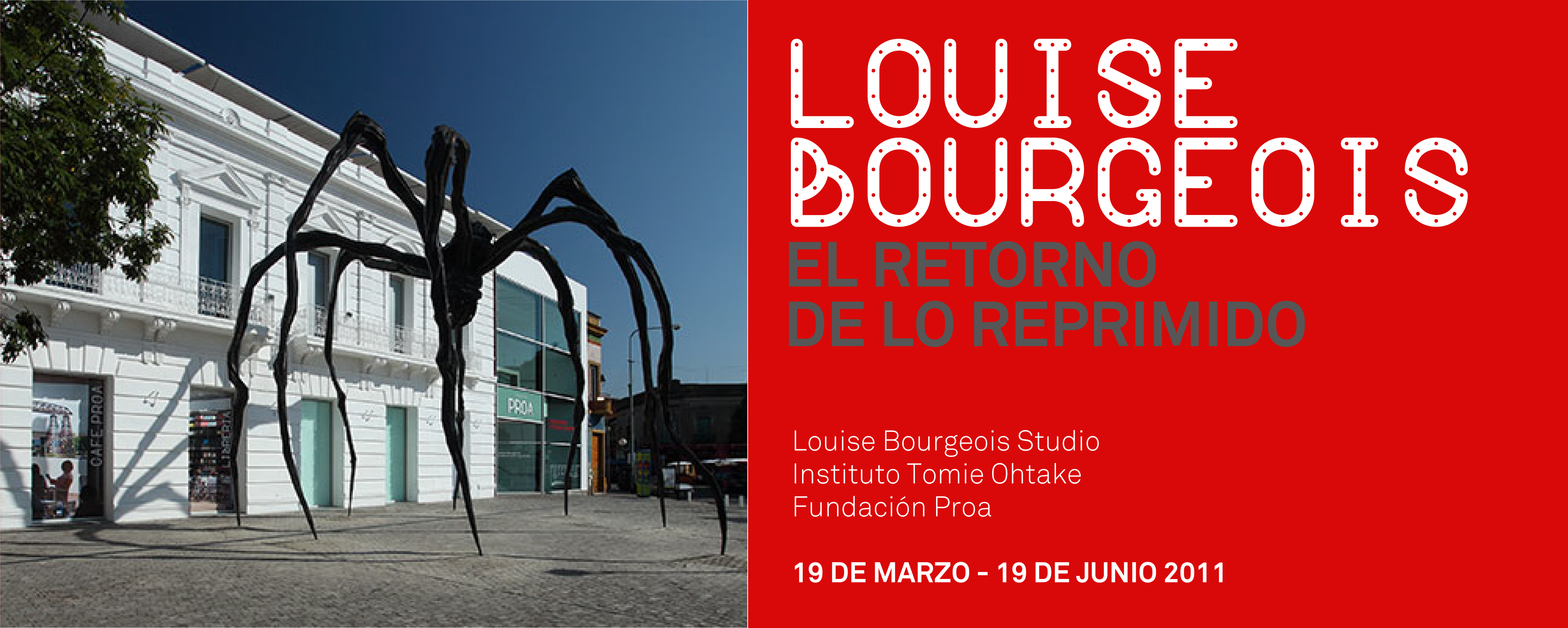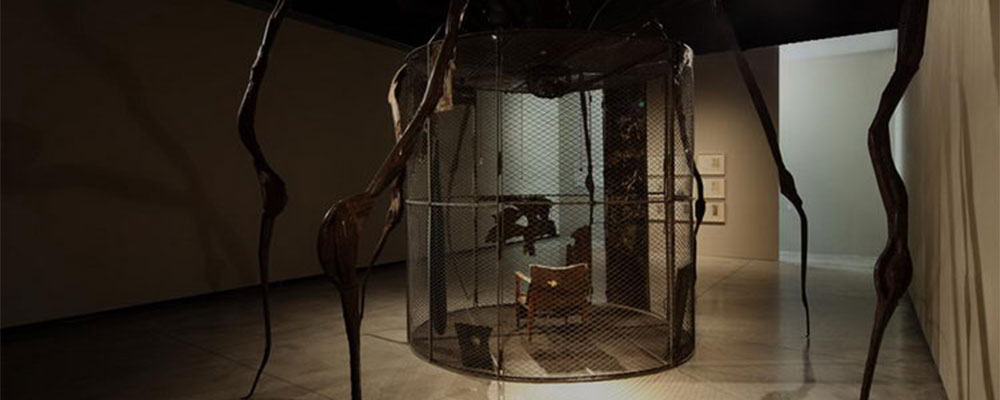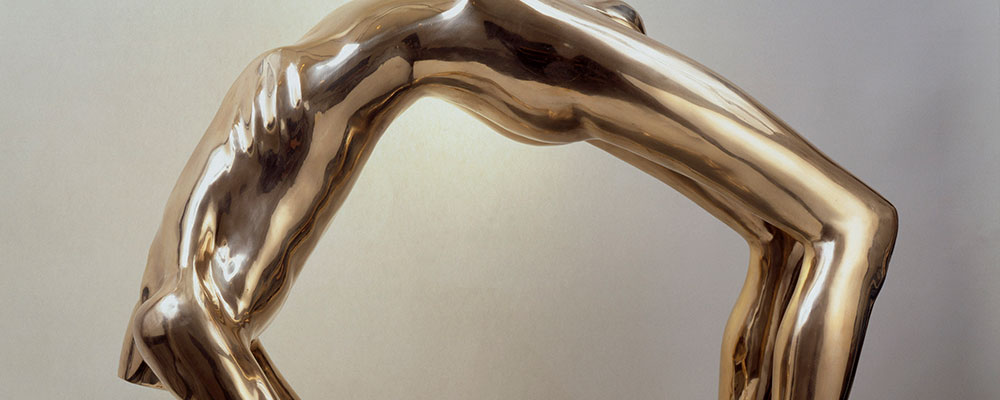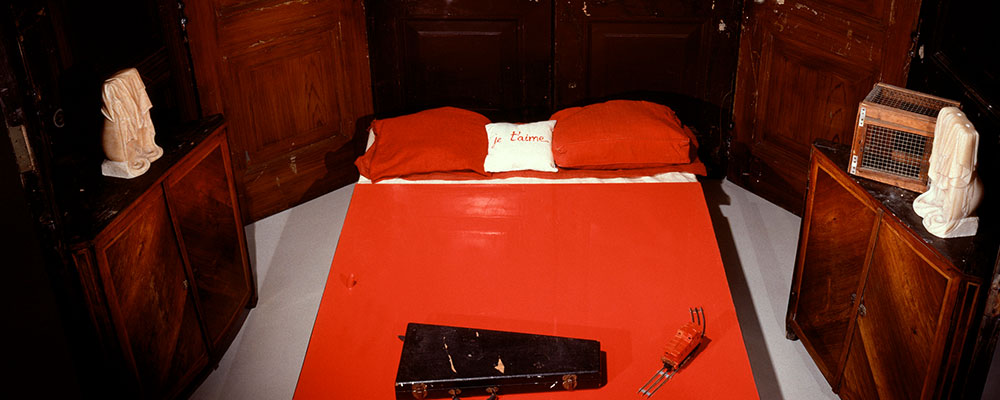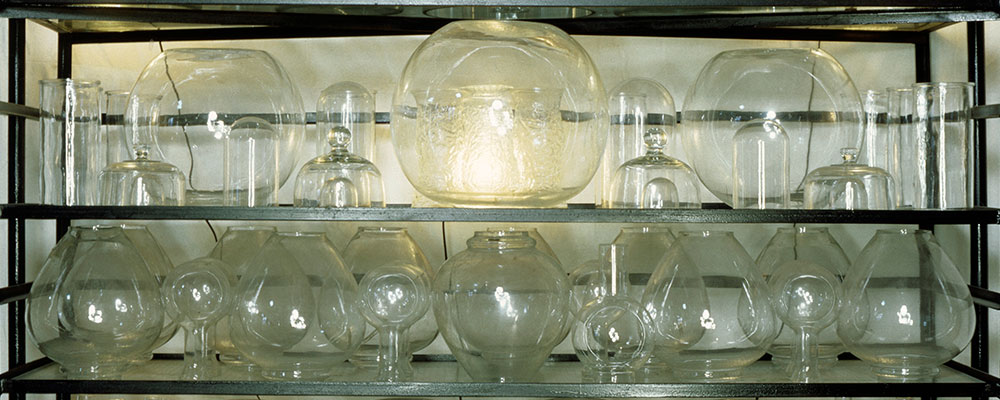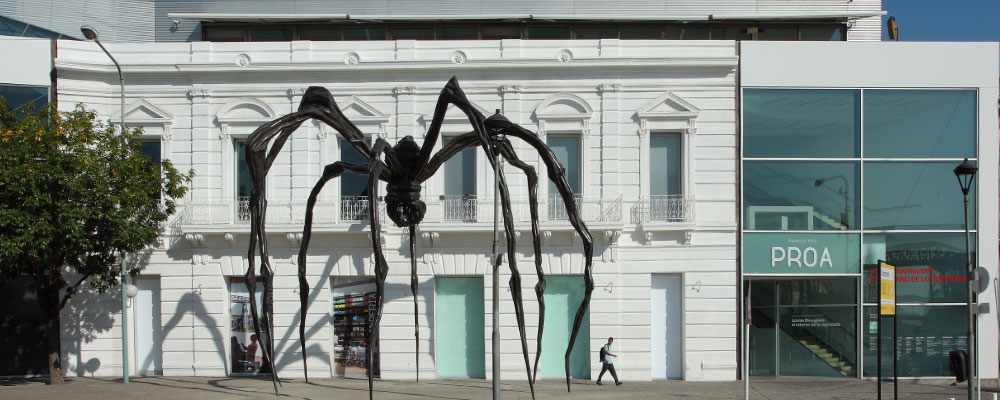Presentation
Fundacion Proa presents for the first time in Latin America the greatest exhibit of work by Louise Bourgeois: the return of the repressed, from March 19th to June 19th, 2011. Bourgeois, one of the most well known artists of the 20th century, was born in Paris in 1911 and traveled and lived in the United States from 1938 until her final days in 2010.
The exhibition opens with the famous spider Maman (1999) displayed in the entrance to Proa, and in the interior rooms display a collection of 86 pieces. Her first sculptures, in which the spiral appears along with various forms and figures that figure prominently in her work, include the Arch of Hysteria, 1993; Spider, 1997, and the emblematic installations Red Room (Parents), 1994, and The Destruction of the Father, 1974. A solid and extensive collection of drawings and sculptures highlight Bourgeois’ radical thoughts and reflections on love: filial, parental, familiar—love itself.
The pieces are a testament to the impact of psychoanalysis on the artist’s thoughts and reveal how her dialogue with this discourse created an emotional universe involving the complexities, conflicts, and subtleties of contemporary life. The interior world, family relationships, the role of the father, the mother, the daughter, and the wife are treated in a singular and personal manner, converting Bourgeois into an icon of the most transcendental themes of the twentieth century.
Her famous hanging pieces, pendants on a string, show the fragility, the delicacy of the events, demonstrating the ambivalence between the exterior world and the interior world of the subject.
Louse Bourgeois: the return of the repressed, curated by Philip Larratt-Smith, is organized in conjunction with the Louise Bourgeois Studio in New York and the Instituto Tomie Ohtake in Sao Pablo, Brazil, and is supported by Tenaris, both for its presentation in Argentina and its tour in Rio de Janeiro and San Pablo.
LOUISE BOURGEOIS: THE RETURN OF THE REPRESSED
Embajada de Estados Unidos en Buenos Aires
Louise Bourgeois Studio, New York
Instituto Tomie Ohtake, Sao Pablo
Fundación Proa
Curator
Philip Larratt-Smith
General Production
Vitoria Arruda / Wendy Williams
Assistents at Fundación Proa
Aimé Iglesias Lukin / Camila Jurado
Expository Design
Louise Bourgeois Studio / Fundación Proa
Montage
Tobias May / Eddie McAveney
Simon Rybansky / Angelika Fredes
Depto. de Montaje de Fundación Proa
Conservation
Angela Freitas

Parallel Activities
To complement the exhibition, a parallel program of reflection and encounters aims to enrich the exploration and understanding of Louise Bourgeois’ work. Every Saturday at 17hs, starting in April, the encounter Artists and Criticsunites distinguished professionals who offer their perspectives on the exhibit.
In the Auditorium, the documentary Louise (Querida Louise) by Brigitte Cornand, 1995 is projected. The film reveals the artist’s passion and inspiration that gave rise to her powerful pieces of work. Set in her house and studio in New York, the film draws on memories from infancy to draw an intimate portrait of an original and active artist. The Spider, the Mistress, and the Tangerine by Marion Cajori & Amei Wallach, is a captivating tour of the world of the legendary artist and over six decades of her work. During the two following decades, she created her most powerful and persuasive pieces, including the monumental sculptures of spiders that have toured the world.
The catalogue
Louise Bourgeois: the return of the repressed, an editorial project by Philip Larratt-Smith, consists of two volumes. One of them reproduces images of the exhibited pieces, an outstanding chronology of her life and work, along with a collection of essays by prominent authors that accompany and enrich Philip Larratt-Smith’s curatorial texts, which focus on the artist’s relationship with psychoanalysis. Rigorously selected by Philip Larratt-Smith, curator of the exhibit, the unedited texts, widely cited but never before reproduced, are translated in Spanish for the first time by Jaime Arrambide. They have never been published in a single volume in English. The texts are evidence of the impact of psychoanalysis on Louise Bourgeois’ creative process and allow us to discover one of the artist’s central creative dimensions: her writings. Notes, impressions, questions, lists, biographical sketches, annotations in the margins of lectures by Freud, Melanie Klein, and Lacan, among others entries, are included. Writings that are pieces of art and art that appears in her writing.
Education
From Tuesday to Sunday at 17:00hs, the Department of Education organizes guided in depth visits. Tuesdays are student days, where reference materials such as books and catalogues are made available to the public in the bookstore. Visits in English available.
For more information: http://proa.org/eng/education.php / +54 11 4104 1041 / educacion@proa.org.
Audio-guide
Downlodad here Louise Bourgeois: The Return of the repressed audio-guide. Available in mp3 format.
About the Fundación Proa
Fundación Proa, one of the most prominent cultural centers in Buenos Aires, presents exhibitions of diverse artistic disciplines along with expository designs, catalogue editions, conferences, and seminars linked to the art of the time. ProaCine, ProaEducacion, and ProaLibrería also have their own program of activities. Located in one of the must PINTORESCOS and historic neighborhoods in Buenos Aires, La Boca, Proa has a unique extraordinary view from the terrace of its café, Café Proa. It is open from Tuesday to Sunday from 11:00 to 19:00.
Fundación Proa is permanently supported by Tenaris, Ternium, Organizacion Techint.
Presentation
by Adriana Rosenberg
--- Art is sacrificing perception in order to impose the aesthetic act of memory.
Charles Baudelaire
The dialogue between art and psychoanalysis is one of the prominent trends of thought of the 20th century and constitutes a fundamental intersection of this new time. It is the moment for the irruption of vacancy, silence, subjectivity, and unconsciousness, which enter the text and images of the work and transform the relationship between art and reality. New forms of narrating experiences and designating previously unnamed feelings have appeared. Neurosis, trauma, and unconsciousness are now active subjects in the discourse, and the dream is a new conception of time. The repressed is wins significance and traverses the split subject that Baudelaire detected in the vertiginous and feverish city of Paris, Lousie Bourgeois’ city of birth. The development of cities brings about a loss of individual identity and determines a new manner of organizing chaos: the concept of the mass. Thus, with the renovation of how people name, look, and conceive of themselves and one another begins an indispensible century.
Through art, it is possible to reconstruct step by step the diverse neurological moments of the relationship between art and psychoanalysis: the efforts that have been made to elucidate the complex personalities of artists, which has been the subject of many essays throughout the century, is proof of this. Louise Bourgeois, a fundamental artist of the 20th century, models a scattered conceptual universe in her work and writings that stage and place a value on the creativity inherent in language: its contradictions, its deeply rooted traditions, and its complex logic.
Buenos Aires, a city where psychoanalysis has randomly found a home, is a city of language, literature, and reflection. This city hosts the first exhibition of Louise Bourgeois in Latin America, which will later be presented in Brazil.
Lousie Bourgeois: the return of the repressed reunites a prominent collection of pieces created between 1942 and 2009. The exhibition expands upon the thoughts and ideas about psychoanalysis articulated by the artist. This curatorial decision was derived from the discovery of unedited writings about Bourgeois’ relationship with her psychoanalyst and her thoughts about psychoanalytic theory. This material was edited for the first time, giving form to almost a hundred thematic texts, whose publication accompanies this exhibition. The curator, Philip Larratt-Smith, recuperates the dialogue between two languages—the image and the written word—and makes them susceptible to the same aesthetic universe.
The exhibit composes a psychoanalytic geography, a map of language and an x-ray of intimate, subjective events that, cast in a psychoanalytic light, invite the spectator to traverse the interior of the psyche, which has been discovered for more than a century.
Gigantic and iconic, the spider MAMAN, from 1999, welcomes us in Proa’s esplanade. Constructive, CONSTRUCTIVA, threatening, and protective, MAMAN is one of the most significant images of the feminine universe. The artist’s proposal to present it in a public space in a great city is simultaneously a reflection, a question, and a demand. For Fundacion Proa, it is a new expository challenge to exhibit this piece in the same way it was exhibited in London, Paris, New York, and Bilbao. From the entrance to Proa, MAMAN both shelters and warns us.
Edited in two volumes, the catalogue Louise Bourgeois: the return of the repressed reproduces the pieces on display in the exhibit and includes an exhaustive biography of the artist and a bibliography of critical and theoretical texts. Prominent academics such as Donald Kspit, Meg Harris Williams, Migmon Nixon, Elisabeth Bronfen and Paul Verhaeghe, and Julie de Ganck accompany and enrich the curator’s perspective, with unedited studies that focus on the value and the importance of psychoanalysis in Bourgeois’ work edited for the first time in Spanish.
Louise Bourgeois’ psychoanalytic writings are another key to accessing the exhibition. In these manuscripts, which until today remained unedited in Spanish as well as in their original language, Louise Bourgeois exposes herself in a naked, intimate, and surprising manner. Her writings provide a tour of her own unconscious, an unknown landscape that she explores through from her psychoanalytic experience and in which the protagonists from her familial story appear. Sketches of revelatory dreams, notebooks filled with notes, diary entries: infancy, the artistic present, and the contradictions between domestic and professional life. Writing that surprises us with its literary scope and poetic freedom.
This unique and extraordinary exhibition was organized thanks to an ensemble of wills: the Instituto Tomie Ohtake in San Pablo, the Louise Bourgeois Studio in New York, and the Fundación Proa in Buenos Aires. Thanks to the initial efforts of Paulo Herkenhoff to promote Bourgeois’ work on our continent, today, after a long period of work, Philip Larratt-Smith’s project for Argentina and Brazil comes to fruition. The plan was made possible initially by relying on Louise Bourgeois’ enthusiasm. We therefore pay homage to her today with this exhibition.
It would be inconceivable to be able to exhibit such an extraordinary body of work without the generous support of Jerry Gorovy, and we offer him our deepest gratitude. An unfathomable figure, Jerry, whose weight is a permanent presence in much of the artist’s work, maintains and guards Louise Bourgeois’ memory. His active and generous presence is a mark of wisdom and reflection for this event. Many thanks as well to The Easton Foundation, which supported the edition of the volume of Bourgeois’ writings in order to amplify the diffusion of her ideas. And thank you to the Louise Bourgeois Studio.
To Bruno Assami and Recardo Othake from the Instituto Tomi Ohtake in San Pablo, and to their entire team for constant organization and support, thank you.
The directors of Tenaris deserve a special mention, as they decided to accompany the exhibition in Brazil as well as in Argentina in their commitment to spreading a seminal body of work in order to advance an understanding of current art and thought. To support Proa in participating in a central chapter of contemporary art reaffirms their unyielding encouragement.
A child’s words, a woman’s drawings, a mother’s sculptures, a patient’s writings. Fundacion Proa completes its annual program and presents once again a historic exhibition that invites the public to experience a unique body of work capable of generating many readings, not only in the art world but also in the field of psychoanalysis, which is especially prominent in Buenos Aires.
